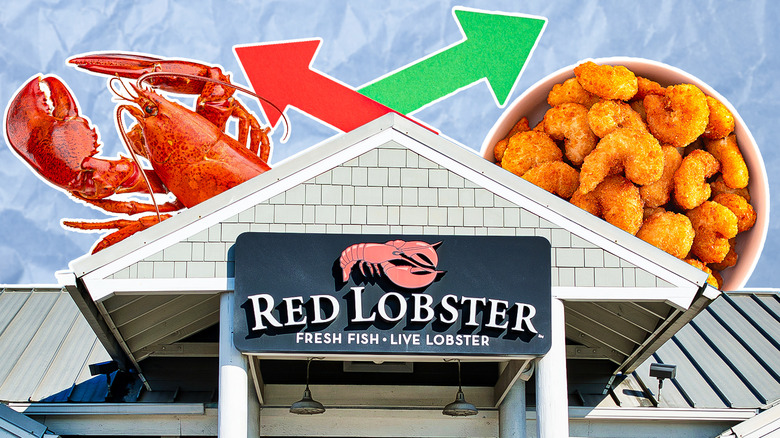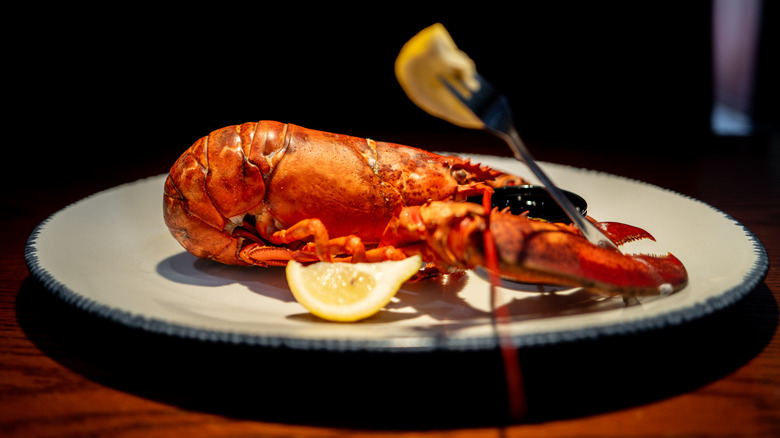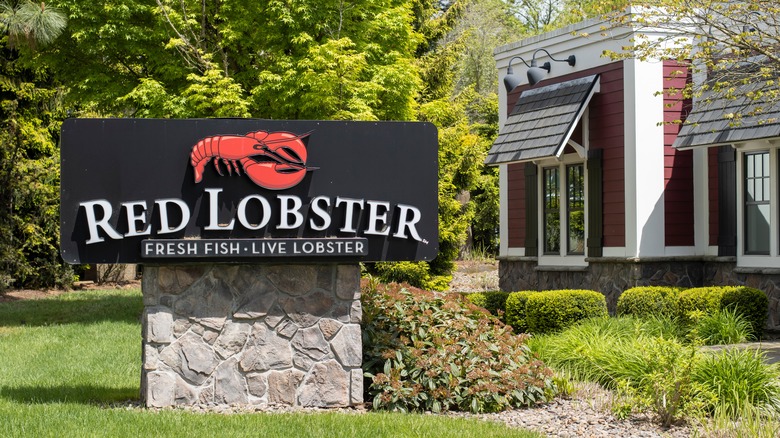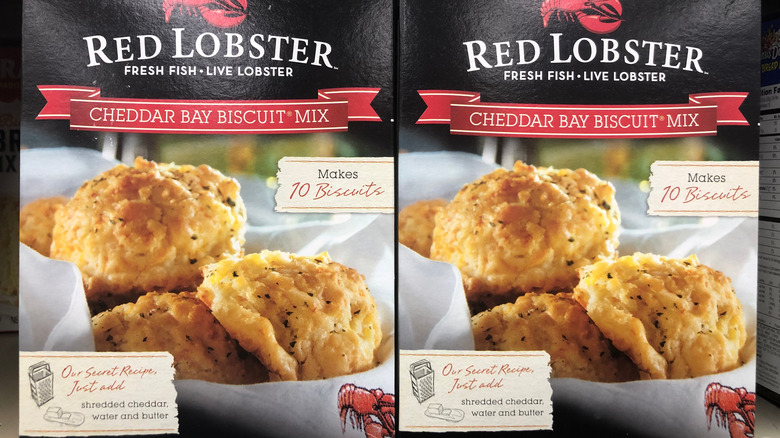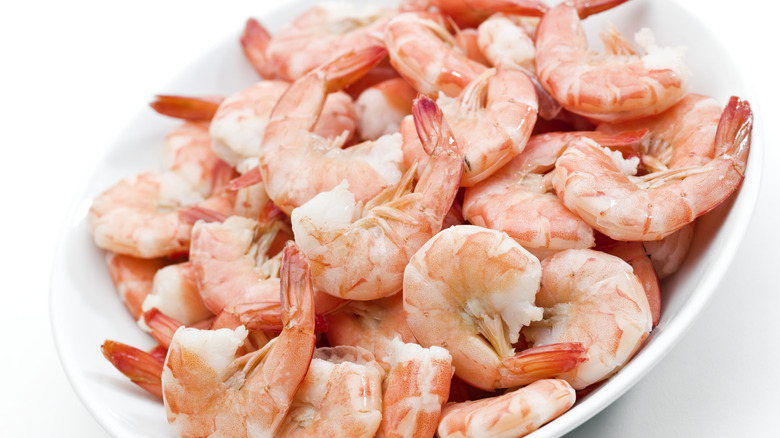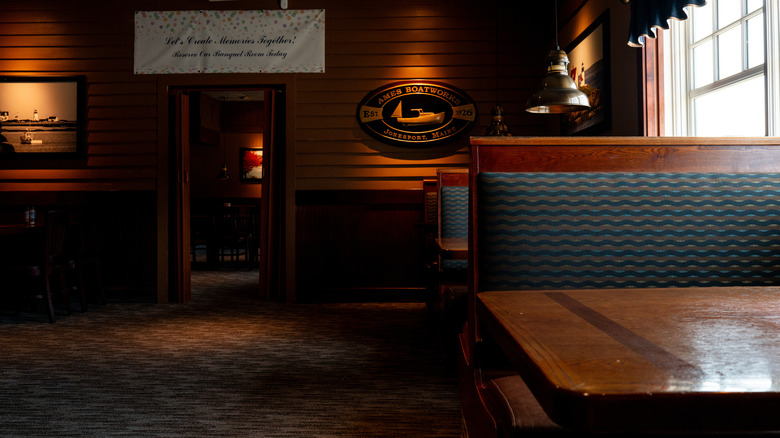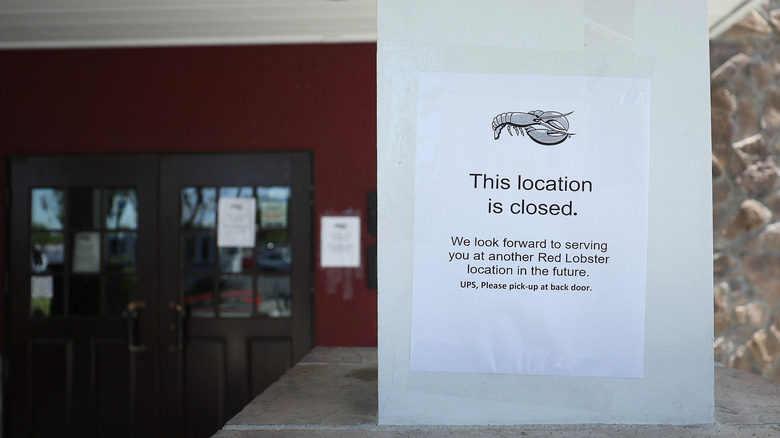Inside The Rise And Fall Of Red Lobster
For many diners, the restaurant known as Red Lobster has become synonymous with family seafood dinners over the decades. But the truth is that this cozy image hasn't been enough to protect it from the ravages of inflation, changing tastes, and a drop in customer numbers. With the company's recent announcement of restaurant closures across the country and its attempt to file for bankruptcy, you would be forgiven for thinking this seems like a problem that popped up out of nowhere. However, it's just one event in a long line of issues that the chain has gone through.
Much of the blame may lie with investor-owners who didn't treat the chain with the right care. The COVID-19 pandemic also took a bite out of the restaurant's business and, now, inflation is making it harder than ever for restaurants to source food, workers to get appropriate pay, and for people to eat out. Yet, currently, the type of bankruptcy that Red Lobster wants to file doesn't necessarily mean the chain will go away, but in the meantime, seeing how far the chain rose up and how fast it fell can be more than a bit alarming. Here's a look at that rise and fall.
Bill Darden started Red Lobster as a standalone restaurant
Red Lobster had modest beginnings as a lone restaurant in Lakeland, Florida. Its founder, Bill Darden, had been running restaurants since the 1930s, and in 1968, he decided he wanted to start a seafood restaurant. That year, he and Charley Woodsby opened up the first Red Lobster location. The restaurant was a success and eventually the co-founders opened two more locations.
Darden's experience with his first restaurant, the Green Frog, taught him that a high level of customer service was vital to the success of a restaurant and its employees, and so it comes as no surprise that he carried that mission over to Red Lobster. When the restaurant opened, many Florida establishments were still segregated and often unwelcoming to Black diners. Darden insisted that the restaurant serve everyone, with no restrictions on who sat where and no difference in how customers were treated or what they were served, regardless of their skin color.
General Mills became interested as the restaurant grew
Eventually, Red Lobster began to expand. By 1970, General Mills became interested in the growing restaurant and made an offer to buy it, as the company wished to expand into the restaurant industry and thought Red Lobster would be a successful addition. Darden and Woodsby sold the restaurants — who wouldn't want that cash, and who wouldn't want to get away from rising lobster prices? — and Darden was then installed as manager. The infusion of cash and support from General Mills made it easier for Red Lobster to expand.
In 1995, General Mills spun Red Lobster and other restaurants off into a subsidiary called Darden Restaurants, Inc. Other chains managed through the subsidiary have come to include Olive Garden and LongHorn Steakhouse. By 2014, though, Darden had sold Red Lobster to private equity firm Golden Gate Capital. Most recently, seafood company Thai Union Group became majority shareholder of Red Lobster in 2020.
The restaurant pioneered popcorn shrimp and Cheddar Bay Biscuits
Many people think of Red Lobster as a place where you can take your family for a sensible dinner that includes great biscuits and popcorn shrimp. But few realize just how historic it is to have those dishes specifically at a Red Lobster location. That's because the chain debuted popcorn shrimp and created some of the most popular biscuits around today. Or at least, it claims that it invented popcorn shrimp though spokespeople are rather tight-lipped about the exact course of that history. The chain's now-iconic Cheddar Bay Biscuits – no Old Bay seasoning is involved — were more clearly created in 1992 as an alternative to hushpuppies.
Red Lobster is also reportedly responsible for one of the most ubiquitous forms of technology around today: the point-of-sale system. Joe Lee, who was an assistant manager at the first Red Lobster restaurant (and later became CEO of Darden), told the Orlando Business Journal in 1998 that he had discovered that some mini-computer systems could collect sales numbers. He had a bowling company create point-of-sale systems to track what was selling and what wasn't an each restaurant in the growing chain. He also put forth the claim that Red Lobster had invented popcorn shrimp.
Its commercial lobster farm appears to have gone nowhere
The management of Red Lobster has long been aware that the demand for lobster is much greater than the actual supply of this shellfish. That's why, in 2012, the company announced that it had entered into a partnership to create the world's first commercial lobster farm, which would have provided a more sustainable supply of lobsters to its restaurant. The Darden Aquafarm was registered in Malaysia in 1999 but only really garnered publicity after Darden announced that a pilot farm was already in business.
However, after 2013, there have been few mentions of this farm. Darden had originally claimed that the main lobster farm would be in operation two years after it disclosed its already-operating pilot farm. Yet, given the lack of news, it appears that little else happened. Red Lobster never said anything, although the chain was sold to private equity firm Golden Gate Capital about a year after the pilot farm announcement. As of 2021, it was claiming that all its lobster was wild-caught.
A bacterial disease devastated the shrimp industry in 2014
In the late 2000s and into the 2010s, Southeast Asian shrimp producers battled a condition hitting shellfish that was known as early mortality syndrome (EMS), more specifically caused by bacteria and now more widely known as acute hepatopancreatic necrosis syndrome. This disease affects juvenile shrimp that aren't old enough to reproduce and, if things go especially wrong, can kill off an entire population of shrimp in a matter of just months. The disease affected the shrimp producers in Vietnam, China, and Thailand. In turn, worldwide shrimp prices went way up. For a seafood restaurant like Red Lobster, that increase in costs proved to be a killer. In 2014, it was hit by a staggering 35% increase in shrimp prices and a subsequent 18% drop in earnings.
That didn't mean that all shrimp everywhere were dying. Restaurants looked to suppliers in relatively unaffected countries like India, which ramped up shrimp farming to help cover the shortfall. Unfortunately for Red Lobster, it was too late; the high prices only made the company's financial situation worse and contributed to its eventual handover to new investors.
Darden agreed to sell off Red Lobster after investor pressure in 2013
The restaurant business is tough, even for chains that appear to be relatively successful. Yet it was clear that Red Lobster was already having financial trouble in 2013, and investor pressure on Darden Restaurants to sell the chain grew to be so great that the company agreed it was time. Yet investors actually weren't happy with how Darden went about this step, with some claiming that they wanted Darden to create a new division to handle Red Lobster and Olive Garden instead, as well as create a real estate investment trust.
But Darden went ahead with the sale, receiving over $2 billion from Golden Gate Capital in 2014 for Red Lobster. After a May 2024 round of closures, it was widely believed that the real culprit behind Red Lobster's fall from grace was the transfer of the restaurant into the hands of private equity. Detractor alleged that private equity companies too often focus on cost-cutting to boost profits, rather than increasing or maintaining quality. According to some, cutting costs at the expense of quality appears to be what happened to Red Lobster.
The latest owner has faced high costs and falling income
After Darden sold Red Lobster to a private equity company, the chain changed hands a few times. The latest majority shareholder is Thai Union Group, a seafood supplier based in Bangkok. It has had to deal with the most trouble due to a combination of lawsuits, scandals, skyrocketing costs, and falling revenue. Thai Union Group first invested in Red Lobster in 2016 and became a majority owner in 2020 after buying 49% of the company's shares. Thai Union Group tried to salvage the company's finances through a combination of cost-cutting and promotions that didn't have the hoped-for effect on sales.
The changes were apparently so detrimental that Red Lobster's own executives criticized the moves and left, adding constantly changing leadership to the restaurant's growing list of woes. Part of the problem was that Thai Union Group is a supplier and not a restaurant management company that might have a better sense of what the chain really needed to thrive.
Plus, it was already a supplier to Red Lobster. The restaurant was already dealing with debt and growing costs, which its investors would have wanted to combat. Yet, some allege that those same investors would have also wanted the company to spend more buying the Thai Union Group's products. They apparently did that in part by pushing out Red Lobster's two other breaded shrimp suppliers.
The company was hit with scandals and lawsuits
The current financial mess isn't the only issue the chain has ever faced. It's also been hit with a major seafood fraud scandal and quite a few lawsuits. The seafood fraud occurred in 2016 when DNA tests revealed that some of the "lobster" Red Lobster was serving was actually langostino lobster, a type of shellfish that is more like a crab with the texture of shrimp. What Red Lobster did is arguably the definition of seafood fraud as it was passing off one type of seafood as another. The chain eventually updated its website to be more open about its use of langostino lobster.
As for lawsuits, in 2017, a Houston woman sued the restaurant chain, claiming that she became so drunk at a Red Lobster restaurant that she fell and injured herself. In 2020, a landlord sued a Red Lobster location in Texas for failing to pay rent. In 2021, the chain faced a class-action suit that claimed its products weren't as sustainable as the chain said they were. And in 2024, an employee who was laid off filed a class-action suit alleging the chain violated the WARN Act, which says companies over a certain size have to provide advanced notice to employees if layoffs are coming up.
The COVID pandemic proved very rocky for Red Lobster
The COVID pandemic wasn't kind to restaurants and was particularly destructive to those that couldn't make the sharp turn from sit-down service to takeout and delivery soon enough. Red Lobster was no exception. The inability to serve customers onsite during the initial shutdowns meant many of the chain's locations fell behind on rent, and the chain barely managed to crawl its way back to almost where it had been before the pandemic.
An odd issue that Red Lobster faced during the pandemic and its aftermath was the fact that its restaurants served seafood, which meant that it could prove controversial for seafood-averse customers where other restaurants could be more agreeable. This might result in people deciding not to go to Red Lobster because one person in the group didn't want seafood. The same predictions suggested that Darden, the group that used to own Red Lobster, would be less impacted by the pandemic because offerings at the restaurants still in its portfolio, such as Olive Garden and The Capital Grille, were more diverse.
It doesn't have a good track record with endless promotions
Red Lobster created its Endless Snow Crab promotion in 2003 and quickly found out the hard way that it really wasn't a good idea. The move was popular, but crab prices rose in response to a government-imposed quota, the chain lost $3.3 million, it almost had to declare bankruptcy, the CEO left, and people sold off many Darden stocks. To many minds, this should have taught the company never to hold all-you-can-eat specials ever again. So, why it thought an Endless Shrimp promotion would be a good idea is anyone's guess. But the chain somehow managed to turn it into a limited time affair that became a yearly event.
Red Lobster decided to go one step further in 2023 and made Endless Shrimp a regular deal. The company ended up losing $11 million (anecdotal reports say customers were actually stuffing shrimp into their pockets). It was too much for even majority owner Thai Union Group, which is looking to sell its now-minority investment in the chain as of early 2024. If Red Lobster had not held the Endless Shrimp promotion, would it be in better shape now? That's unknown, given all it's faced in the past few years. But there's no doubt that the promotion and subsequent losses were a wake-up call.
Endless shrimp was only the final straw
No, the Endless Shrimp deal did not kill Red Lobster on its own. But it sure didn't help, and you can think of it as the last straw that led to the company finally deciding to address its poor financial performance and declare bankruptcy. Red Lobster has been beset by negative factors for years, including inflation, falling income, extensive debt, a lack of concern over upgrading locations and increasing food quality, and leases that were much too expensive.
The leases are a particular problem because Red Lobster used to own its locations. But when Darden sold the chain, the private-equity buyer sold off the locations, then leased them back. The chain no longer controlled the cost of the locations and was now at the mercy of the company that had bought the physical properties. What was worse was that leases required restaurants to pay for additional expenses like property taxes, even though the restaurants were no longer the owners.
Customer traffic has dramatically dropped
Red Lobster hasn't been immune from the inflation hitting the restaurant industry, and the company's been financially hit from multiple directions. For one, inflation is making it harder for customers to afford eating out, so fewer show up and order. It has also made the cost of everything go up, so the chain isn't keeping as much of that dwindling income as it used to. Shrimp prices in particular have soared. When the company launched its Endless Shrimp deal in the summer of 2023, prices had slumped a bit, but they rose rather quickly after August 2023 and further hit Red Lobster's struggling finances.
Inflation isn't the only cause of the noticeable drop in customer traffic, however. Younger people appear to hold a poor image of the chain, considering it to be a place older people go to. Yet even older people have started to see the company as not very interesting. But at least research indicates that this perception seems to be hitting a number of casual sit-down chains and not just Red Lobster.
Only about 15% of its locations have shut down
Despite the worrisome headlines, as of this writing, only about 15% of Red Lobster locations shut down in the most recent wave of closures. As of May 2024, the chain had closed 99 out of 649 restaurants. That's still bad news for the workers and customers at the shuttered restaurants, but that leaves a majority of locations still in operation. About 50 Red Lobster restaurants that were closed were already putting furniture and other goods up for auction at the end of May 2024.
More closures could be on the way. The company is renegotiating leases for many of its locations, and high rents are putting more restaurants on the company's list of potential closures. We're not kidding when we say that rent is high; at the company's huge Times Square location, the new rental rate of reportedly $2.2 million a year is believed to be double what the restaurant had been paying.
